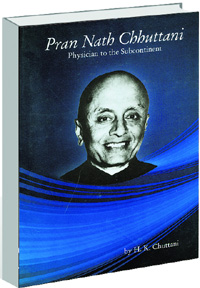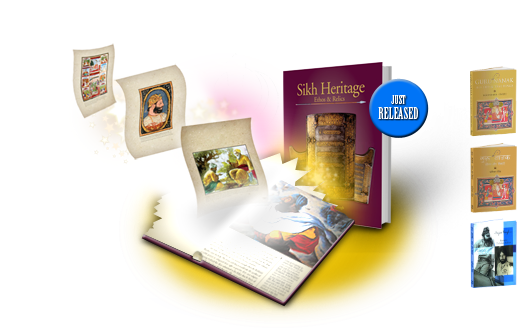Legacy of one who led by example
Pran Nath Chhuttani: Physician to the Subcontinent
By H. K. Chuttani. New Apcon.
Pages 260. Rs 450.
Reviewed by Roopinder Singh
CHANDIGARH has been fortunate in the people who made it their home. Dr Pran Nath Chhuttani’s association started with the inception of the PGI in the city. He gave up a flourishing practice in Amritsar and moved to the new city in the 1960s to take part in Partap Singh Kairon’s vision of creating an institute of medical excellence in the new capital of Punjab.
People came to know him as an eminent doctor; a long-serving Director of the PGI, which he headed from 1969-78; founder of the Chandigarh Medical Centre, which was named Chhuttani Medical Centre after his death; a Trustee of The Tribune… in short, as a prominent citizen of Chandigarh who left his mark on the city and its institutions.
We know more about the man who was born on February 26, 1915, at Leiah, Pakistan, thanks to a slim volume written by his cousin and student, Prof H. K. Chhuttani, former Director, GB Pant Hospital, New Delhi, which fleshes out the person behind the persona. With the affectionate access of a family member, we are taken into the world of Rai Bahadur Tilok Chand, P. N. Chhuttani’s grandfather, and the inhospitable terrain of Leiah, which became the crucible that forged the character of many members of this remarkable family.

Dr P.N. Chhuttani (1915-1996)
Even before Dr Chhuttani earned his MBBS from Punjab University, Lahore, in 1938, he volunteered as a student to help the patients from the Quetta earthquake of 1935. Unfortunately, he developed fulminant dysentery, for which he had to be hospitalised for a long time.
We learn of the man he idolised — his teacher Major-General Amir Chand. When asked by the latter if it was essential for the young man to attend his elder brother’s wedding, the answer was: “No, Sir”. Chhuttani continued to take care of his patients and did not attend it.
We meet Mrs Lakshmi Shersingh, Dr Chhuttani’s Chaachi (aunt). A radiologist and Sanskrit scholar, she drove her own car in the 1930s and was quite at ease with European colleagues. A remarkable woman, she was an ardent Gandhian who converted Dr Chhuttani to vegetarianism. He stuck to it even as he joined the British Army and served in the Army Medical Corps in Persia and Iraq.
After Independence, when the family lost its home in Pakistan, he moved with his father, Rai Sahib Rup Narain, to Gangtok, where the latter was Chief Judge. Dr Chhuttani was soon selected for a Commonwealth Scholarship in the United Kingdom. He returned to India in 1949 and joined the Medical College, Amritsar.
 The author brings to light many aspects of Dr Chhuttani’s personality and does not shy away from dealing with some controversies that came up during his stewardship of the PGI, notably the death of Justice D. S. Lamba and certain questions regarding the treatment of Jaiprakash Narain at the institute. He deals with the issues at some length to show how Dr Chhuttani managed the crisis, and how he was eventually vindicated. He was widely recognised as an eminent doctor, teacher and a guru. He was awarded the Padma Bhushan, Dr B.C. Roy National Award, and Shakuntla Amir Chand Prize of the ICMR. He published more than 150 original research papers on health sciences. As President of The Tribune Trust, he played a major role in increasing the presence of the paper in the national capital and in getting land in Gurgaon to establish a printing press.
The author brings to light many aspects of Dr Chhuttani’s personality and does not shy away from dealing with some controversies that came up during his stewardship of the PGI, notably the death of Justice D. S. Lamba and certain questions regarding the treatment of Jaiprakash Narain at the institute. He deals with the issues at some length to show how Dr Chhuttani managed the crisis, and how he was eventually vindicated. He was widely recognised as an eminent doctor, teacher and a guru. He was awarded the Padma Bhushan, Dr B.C. Roy National Award, and Shakuntla Amir Chand Prize of the ICMR. He published more than 150 original research papers on health sciences. As President of The Tribune Trust, he played a major role in increasing the presence of the paper in the national capital and in getting land in Gurgaon to establish a printing press.
A bachelor, he was a sociable person and the biography has vignettes, which show him as a man who put in long hours at work, a strict disciplinarian who preferred to eat at home, punctual, caring and quite a sportsman. People of the region will find fresh information on many familiar events. He led by example. Proud of the record of the PGI in performing autopsies, he had asked that one be performed on him too, which was done after he passed away on July 16, 1996. In his lifetime, he set up the Tirlok Tirath Vidyavati Chhuttani Charitable Trust, and willed his considerable property to it. This inspired his father, elder sister and brother-in-law, Dr Amolakh Singh Arora, also to do the same. The trust is dedicated to medical relief and research. His lasting legacy is also the physicians who he trained and continue their work inspired by a man who attained the status of a legend in his lifetime.
This book review was published on November 3, 2013 in the Spectrum section of The Tribune.



